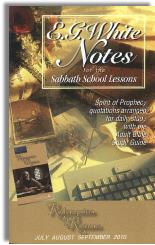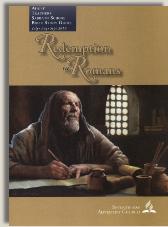|
||||||||||||||
Commentary on "Expounding the Faith"
Day 5: Wednesday, August 4, 2010 - Law Awakens Need
Day 6: Thursday, August 5, 2010 - The Second Adam
Overview
“He is talking about the time in the world from creation to Sinai, before the formal introduction of the rules and laws of the Israelite system, which included, of course, the Ten Commandments.” (Adult Teachers Sabbath School Bible Study Guide; July, Aug, Sept, 2010, Page 72, emphasis part of the original quotation)
Observations
The problem with Wednesday’s section is not with the texts used or the explanation, except in one point. Alas, it’s a big point.
The purpose of this section is not to explain what Paul is talking about in Verses 13, 14, 20 and 21. It is to reassert the Adventist position that the Ten Commandments are binding on children of God today. To do so requires some interesting sleight-of-hand, but Adventists are good at it.
First, they define sin as bad behavior – stealing, telling lies, adultery, etc.
Second, because these behaviors always have been wrong, then they argue that the Ten Commandments must always have been in place.
Sin is not bad behavior. Bad behavior is the result of sin. What is bad behavior? Anything that does not come from faith (Romans 14:23, and note the wider context). Another way of saying this is that bad behavior is the result of disbelief. This means that “bad” behavior can include any number of very good activities, when these good activities are done in the flesh.
Therefore, leading someone to Jesus for salvation may be the most blessed event in that person’s life, but it may be sinful for the person doing the leading. If you don’t believe this, just take a look at the number of pastors who burn out. They get so tired of living a lie, of doing and doing and doing, of never being able to measure up to their own or their congregation’s expectations. At its core, this is the result of doing God’s work in the flesh, and it is sinful.
Sin and death (the result of sin) reigned from Adam to Moses because unbelief reigned from Adam to Moses. Adam and Eve started it. They chose to believe Satan instead of God, and the result of their unbelief was eating the forbidden fruit. The result of their sin (unbelief) and its result (eating) was death.
They didn’t sin because some unstated law told them not to covet, yet they coveted anyway. They coveted because they had already sinned. They had disbelieved God, and coveting was one of many behaviors and attitudes that followed.
The Law, including the Big 10, the sacrificial system, and the requirements for society as a whole (eating, living, dealing with conflict, etc.), was given so that “transgression would increase” (Verse 20). The lesson gets it right on this point, the Law shows us the sinfulness of sin.
It’s too bad that Verses 12-21 were not covered as one section, because they really are just one argument – the first Adam vs. the second Adam (Jesus).
Again, all but one part of Thursday’s section is pretty good, and, again, that one part is a very serious flaw. Here’s the quotation:
“The second Adam was a free moral agent, held responsible for his conduct. Surrounded by intensely subtle and misleading influences, He was much less favorably situated than was the first Adam to lead a sinless life. Yet in the midst of sinners He resisted every temptation to sin, and maintained His innocency. He was ever sinless.”—Ellen G. White Comments, The SDA Bible Commentary, vol. 6, p. 1074. (Ibid, Page 74)
Here we have the most subtle and pernicious of SDA errors – the nature of Jesus. This particular quote is not as egregious as others, but that’s what makes it so dangerous.
On the surface, it appears that Mrs. White is saying that both Adam and Jesus were required, and were able in and of themselves, to lead a sinless life. This is wrong, but it covers an even greater error.
The SDA church believes that Jesus had a sin nature; that he was just like you and me. First, if this was true, then Jesus would need a savior; he could not be the Savior. Second, this would mean that Jesus was not God. Therefore, he could not be the Savior.
Paul didn’t call Jesus the second Adam because he needed to use a catchy phrase. Paul is saying that Jesus was born sinless, just as Adam was created sinless. Sinning for both of them was a foreign, unimaginable idea, that is, unless they chose to go it alone, to be their own god. Clearly, Adam failed. He chose to disbelieve. Clearly, Jesus succeeded. He chose to live in perfect, continual dependence on the Father.
Jesus didn’t wrestle with idolatry or lust like you and I do, but he faced the temptation to rely on his innate “Godness” at every step of the way. Remember, our temptations regarding idolatry and lust are really the temptations to rely on our own strength in order to avoid bad behavior. This is why Jesus was tempted in all points like us. He could have succeeded in his own strength, but he chose to walk by faith in reliance on the Father. We cannot succeed in our own strength, but we can choose to walk by faith in reliance on the indwelling Holy Spirit.
Summary
- Please don’t use Romans 5 as a “proof” that the Ten Commandments existed before Sinai. They did not.
- Sin, the choice to disbelieve God while doing anything in my own strength, did exist before Sinai. As a result, death reigned from Adam to Moses.
- The lesson actually does a pretty good job of mentioning the incredible contrasts between being “in Adam” and being “in Christ,” but these good points are lost in the errors of keeping people under the Law and of denying Jesus’ sinless nature.
Copyright 2010 BibleStudiesForAdventists.com. All rights reserved. Revised July 12, 2010. This website is published by Life Assurance Ministries, Glendale, Arizona, USA, the publisher of Proclamation! Magazine. Contact email: BibleStudiesForAdventists@gmail.com.
The Sabbath School Bible Study Guide and the corresponding E.G. White Notes are published by Pacific Press Publishing Association, which is owned and operated by the Seventh-day Adventist church. The current quarter's editions are pictured above.
Official Adventist Resources
Standard Edition Study Guide Week 6
Teacher's Edition Study Guide Week 6
Easy Reading Edition Study Guide Wk 6
Search the Complete Published Ellen G. White Writings


